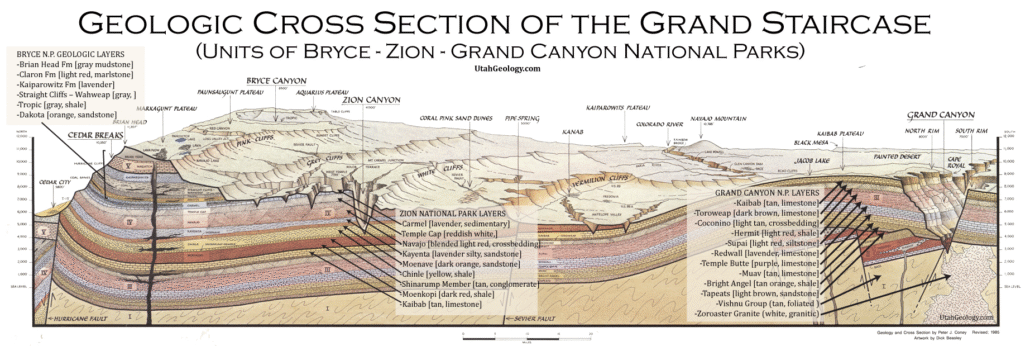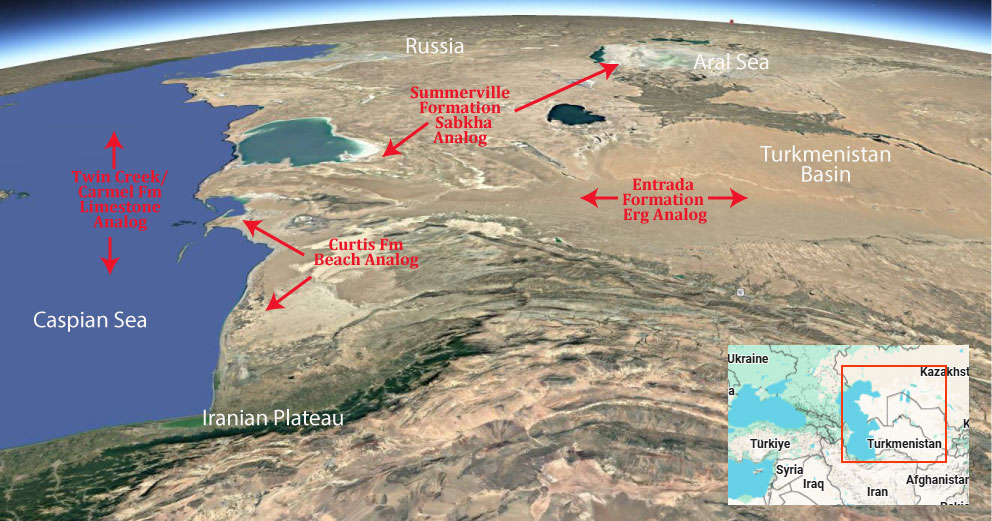Esplanade Sandstone & Cutler Cedar Mesa Sandstone (Geology of The Grand Canyon)

Explore unit thickness in All-in-One App

Exposure:
The Esplanade Sandstone is the upper member of the Supai Group and forms a prominent bench visible throughout the Grand Canyon. It is time equivalent to the upper Culter Group units, the Cedar Mesa & Elephant Canyon Formations.
Age: Early Permian, 290–294 million years ago.
Depositional Environment: deposited in a nearshore eolian, or wind-blown, environment. Specifically, it formed along the western edge of the ancient Pangaean Supercontinent. The Hermit Shale, which sits above the Esplanade, was deposited in a fluvial and coastal plain environment. The Esplanade Sandstone is part of the Supai Group, which generally represents a diverse range of environments, but eolian sands are most prevalent.
Paleogeography: Like most Grand Canyon units, the region was likely the western coast of the North American craton during much of the Paleozoic.
Tectonics: The collision of the Gondwana Plate with the North American Plate resulted in the Uncompahgre highland.
Climate: generally dry, with eolian (wind-blown) environments prevalent
Features: The Esplanade/Cedar Mesa Sandstones are a significant feature of the Grand Canyon & Canyonlands, forming a prominent shelf or terrace about a fourth of the way down from the rim. It’s a resistant sandstone, dark red in color, and plays a crucial role in the canyon’s landscape. This rock unit is a key element in creating a “canyon within a canyon” effect, as the Hermit Formation overlies it, forming the slopes below.
The Esplanade Sandstone is characterized by its cliff-forming nature and resistance to erosion, leading to its distinctive shelf formation. It’s also notable for its origin, formed from desert sand dunes that were subsequently compacted and cemented over long geological timescales. This formation also supports a unique ecosystem, with cyanobacteria, lichens, and mosses thriving on its surface, contributing to the overall biodiversity of the canyon.
The Esplanade Sandstone’s presence is particularly visible at locations like Toroweap Overlook and the east side of the canyon. The Esplanade Route trail, named after the sandstone, further highlights its prominence in the canyon’s landscape. Its resistant nature and distinctive color make it a visually striking and geologically important part of the Grand Canyon’s features.
Similarly, the Cedar Mesa forms a prominent shelf of the Hite region and may be lithologically equivalent as well as time equivalent (research this).



Description:
The Lower Permian Esplanade Sandstone is a cliff-forming, resistant sandstone, dark red, geologic unit found in the Grand Canyon. The rock unit forms a resistant shelf in the west Grand Canyon, south side of the Colorado River, at the east of the Toroweap Fault, down-dropped to west, southeast of Toroweap Overlook (North Rim, at Lava Falls), and west of Havasupai. The red, sandstone shelf, The Esplanade is about 20-mi long. At Toroweap Overlook region, Toroweap Valley with Vulcan’s Throne, Uinkaret volcanic field, the resistant Esplanade Sandstone is described in access routes exploring the Toroweap Lake area (Hike 17, Vulcans Throne).[2]
The Esplanade Route–(trail), of the east Grand Canyon is also named for the Esplanade Sandstone. The coeval sandstone geologic unit from eastern Utah is the Cedar Mesa Sandstone
The Supai Group members were created from marine (oceanic) sequences of marine transgression, and regression, thus the alternating sandstone, siltstones, conglomerate subsections (facies); the subsections are not always a continuous transition into the above section, mostly due to ocean levels, falling, or rising, glaciation, or regional subsidence–(basins, etc.) or uplift of land. Today’s Wasatch Front is the approximate lineage, NNE to SSW of the western coast region of North America from where the oceans transgressed. The ancient Antler Mountains–(Antler orogeny, off-shore volcanic island arch(es)), of ancient Nevada supplied material, from the west, off the ‘ancestral’ West Coast. The continent supplied material from the east, both directions supplying the offshore basin, the Cordilleran Basin which became part of the Basin and Range Province, in later epochs. Three other basins were involved in this history: southwest of the Ancestral Rocky Mountains was the Paradox Basin–(eastern Utah to Southwest Colorado), northeast was the Central Colorado Basin–(NW Colorado, NE Utah, SW Wyoming); the Oquirrh Basin was north-northwest, at present day northwest Utah.
Modern Analog to Utah’s Middle Jurassic

.
Paleogeography or Depiction of Utah during Middle Jurassic

What is the Grand Staircase?
The Grand Staircase is a unique and extensive exposure of Earth’s history, showcasing over 200 million years of sedimentary rock layers. Geologists often liken these layers to a “book,” allowing for a detailed study of the Earth’s past, including changes in climate and environment.
The major sedimentary rock units exposed in the Grand Canyon range in age from 200 million to 600 million years and were deposited in warm shallow seas and near-shore environments. The nearly 40 identified rock layers of Grand Canyon form one of the most studied geologic columns in the world.


